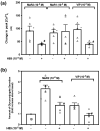Signaling Pathways Used by the Specialized Pro-Resolving Mediator Maresin 2 Regulate Goblet Cell Function: Comparison with Maresin 1
- PMID: 35682912
- PMCID: PMC9181304
- DOI: 10.3390/ijms23116233
Signaling Pathways Used by the Specialized Pro-Resolving Mediator Maresin 2 Regulate Goblet Cell Function: Comparison with Maresin 1
Abstract
Specialized pro-resolving mediators (SPMs), including Maresins (MaR)-1 and 2, contribute to tear film homeostasis and resolve conjunctival inflammation. We investigated MaR2's signaling pathways in goblet cells (GC) from rat conjunctiva. Agonist-induced [Ca2+]i and high-molecular weight glycoconjugate secretion were measured. MaR2 increased [Ca2+]i and stimulated secretion. MaR2 and MaR1 stimulate conjunctival goblet cell function, especially secretion, by activating different but overlapping GPCR and signaling pathways, and furthermore counter-regulate histamine stimulated increase in [Ca2+]i. Thus, MaR2 and MaR1 play a role in maintaining the ocular surface and tear film homeostasis in health and disease. As MaR2 and MaR1 modulate conjunctival goblet cell function, they each may have potential as novel, but differing, options for the treatment of ocular surface inflammatory diseases including allergic conjunctivitis and dry eye disease. We conclude that in conjunctival GC MaR2 and MaR1, both increase the [Ca2+]i and stimulate secretion to maintain homeostasis by using one set of different, but overlapping, signaling pathways to increase [Ca2+]i and another set to stimulate secretion. MaR2 also resolves ocular allergy.
Keywords: epithelial cell; eye; inflammation; intracellular Ca2+; mucin secretion; tear film.
Conflict of interest statement
The authors declare no conflict of interest. The funders had no role in the design of the study; in the collection, analyses, or interpretation of data; in the writing of the manuscript, or in the decision to publish the results.
Figures











Similar articles
-
Maresin 1, a specialized proresolving mediator, stimulates intracellular [Ca2+ ] and secretion in conjunctival goblet cells.J Cell Physiol. 2021 Jan;236(1):340-353. doi: 10.1002/jcp.29846. Epub 2020 Jun 8. J Cell Physiol. 2021. PMID: 32510663 Free PMC article.
-
Signaling pathways activated by resolvin E1 to stimulate mucin secretion and increase intracellular Ca2+ in cultured rat conjunctival goblet cells.Exp Eye Res. 2018 Aug;173:64-72. doi: 10.1016/j.exer.2018.04.015. Epub 2018 Apr 25. Exp Eye Res. 2018. PMID: 29702100 Free PMC article.
-
Resolvin D2 elevates cAMP to increase intracellular [Ca2+] and stimulate secretion from conjunctival goblet cells.FASEB J. 2019 Jul;33(7):8468-8478. doi: 10.1096/fj.201802467R. Epub 2019 Apr 23. FASEB J. 2019. PMID: 31013438 Free PMC article.
-
Immunoresolvent Resolvin D1 Maintains the Health of the Ocular Surface.Adv Exp Med Biol. 2019;1161:13-25. doi: 10.1007/978-3-030-21735-8_3. Adv Exp Med Biol. 2019. PMID: 31562618 Free PMC article. Review.
-
Reconsidering the central role of mucins in dry eye and ocular surface diseases.Prog Retin Eye Res. 2019 Jul;71:68-87. doi: 10.1016/j.preteyeres.2018.11.007. Epub 2018 Nov 22. Prog Retin Eye Res. 2019. PMID: 30471351 Review.
Cited by
-
Possibility of averting cytokine storm in SARS-COV 2 patients using specialized pro-resolving lipid mediators.Biochem Pharmacol. 2023 Mar;209:115437. doi: 10.1016/j.bcp.2023.115437. Epub 2023 Jan 30. Biochem Pharmacol. 2023. PMID: 36731803 Free PMC article. Review.
-
Pyrimidinergic P2Y1-Like Nucleotide Receptors Are Functional in Rat Conjunctival Goblet Cells.Invest Ophthalmol Vis Sci. 2025 Jan 2;66(1):46. doi: 10.1167/iovs.66.1.46. Invest Ophthalmol Vis Sci. 2025. PMID: 39836405 Free PMC article.
-
Potential Clinical Applications of Pro-Resolving Lipids Mediators from Docosahexaenoic Acid.Nutrients. 2023 Jul 26;15(15):3317. doi: 10.3390/nu15153317. Nutrients. 2023. PMID: 37571256 Free PMC article. Review.
-
Maresin: Macrophage Mediator for Resolving Inflammation and Bridging Tissue Regeneration-A System-Based Preclinical Systematic Review.Int J Mol Sci. 2023 Jul 2;24(13):11012. doi: 10.3390/ijms241311012. Int J Mol Sci. 2023. PMID: 37446190 Free PMC article.
References
-
- Argueso P., Balaram M., Spurr-Michaud S., Keutmann H.T., Dana M.R., Gipson I.K. Decreased levels of the goblet cell mucin MUC5AC in tears of patients with Sjogren syndrome. Investig. Ophthalmol. Vis. Sci. 2002;43:1004–1011. - PubMed
-
- Dogru M., Matsumoto Y., Okada N., Igarashi A., Fukagawa K., Shimazaki J., Tsubota K., Fujishima H. Alterations of the ocular surface epithelial MUC16 and goblet cell MUC5AC in patients with atopic keratoconjunctivitis. Allergy. 2008;63:1324–1334. doi: 10.1111/j.1398-9995.2008.01781.x. - DOI - PubMed
MeSH terms
Substances
Grants and funding
LinkOut - more resources
Full Text Sources
Research Materials
Miscellaneous

